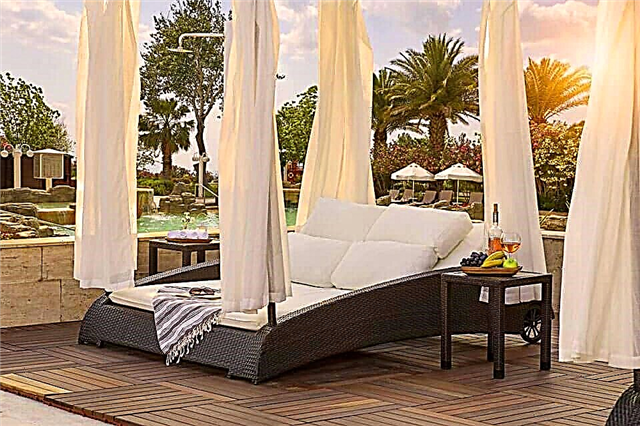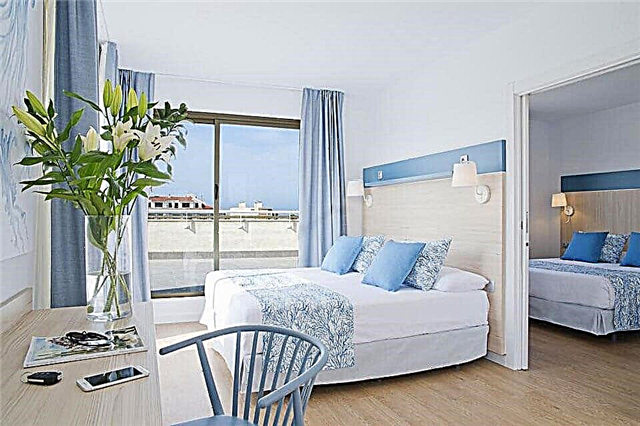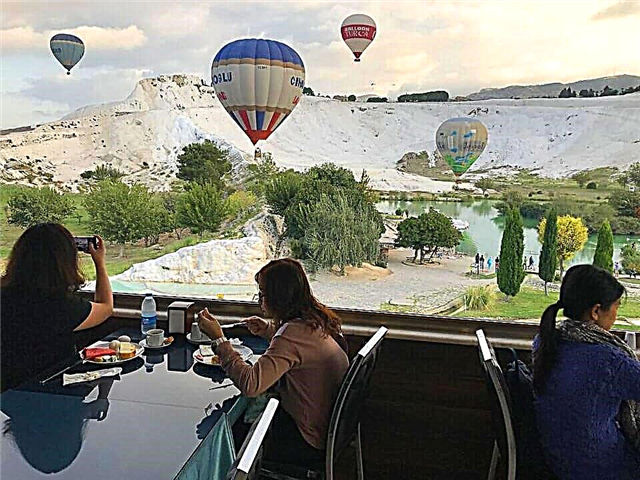In the south-west of Turkey, there is a unique complex with geothermal springs, which has no analogues in the world. When you find yourself at the foot of a snow-white mountain, it seems that before your eyes there are snow-capped peaks that have come from nowhere in the middle of the Mediterranean green landscapes. Warm mineral water flows underfoot, pools with the purest geyser water look relief and mesmerizing, and the dazzling white terraces go up 150 meters. Pamukkale is included in the UNESCO World Heritage List and is visited annually by one and a half million tourists. Nearby are the ruins of the ancient cities of Hierapolis and Aphrodisia, where you can literally touch the ancient artifacts. Many travel agencies offer the organization of excursions, but going to Pamukkale on your own is much more interesting and budgetary. And most importantly, you yourself choose which sights to visit, how much time to spend on each of them, which way of transportation to choose and, finally, which hotel you will like if you wish to stay at this unique resort.
How to get there on your own

The closest airport to the destination is in the city of Denizli, from there you can get to the thermal resort by bus in an hour. Ride on the shuttle "Turkish Airlines" costs 10 liras, and on the bus company "Baytur" 26 liras. If you land in the city of Izmir, the journey to the mineral resort by bus will be at least 5 hours by bus or 7 hours by train.
A train trip is possible only from Izmir to Denizli, after which you will have to change to a bus or rent a car. It is better to arrange car rental in Turkey via the Internet by concluding an agreement with an international company. Street rentals will offer temptingly low cost of service, but in this case you are not insured against problems with both insurance and the car itself. Keep in mind that the most expensive car rental is at the hotel and airport.
Where to stay
In the vicinity of the snow-white mountain, oozing mineral springs, there is a choice of accommodation options, including five-star hotels. Focusing on the comfortable room rate for you, the availability of the necessary services and the location of the hotel, you can very quickly resolve the issue of accommodation.
Doga Thermal Health & Spa 5 *


7 kilometers from the dazzling travertine is a five-star hotel with a spa complex. Whichever room you book, it will have a view of the mountains. A varied breakfast buffet, 2 swimming pools, spacious rooms, high quality service and just 10 minutes by car to the mineral springs. You can take a walk in the spacious garden, warm up on a sun lounger or visit the spa complex, whose services are offered at affordable prices.
Richmond Pamukkale Thermal 5 *


The thermal hotel is located 3 kilometers from the mineral travertine. In 2015, it was completely renovated. The indoor pool is filled with thermal water, there is a small pine forest on the territory, from which the aroma of coniferous freshness emanates. The spa offers a hammam, sauna, adventure cave and gym. Varied buffet breakfasts are served in the restaurant, where you can taste delicious Turkish national cuisine and dishes from the European menu.
Hierapark Thermal & SPA Hotel 5 *


Distance to travertine fonts - 4 kilometers. There is a mini-water park for children on the territory, and adults can relax, recuperate and improve their health in the spa complex. There is a hammam, sauna and steam bath. Lush olive and pomegranate trees create a cozy atmosphere of unity with nature. Guests are offered an airport shuttle, a restaurant with a varied menu, spacious comfortable rooms.
Venus Suite Hotel


Venus Suite is located just 300 meters from the ancient city of Hierapolis. There is a free shuttle to Pamukkale center every 30 minutes. This cozy small hotel was completely renovated and refurbished in 2015. The territory has a swimming pool, garden and vegetable garden, balconies in the rooms. Facilities for people with disabilities are provided. Breakfast is served buffet style, free wi-fi is available on site.
Pamukkale Melrose Viewpoint Suites


The proximity to travertine terraces - just 700 meters from the entrance - makes this accommodation option very attractive for resort guests who decide to stay at the unusual resort for a short time. The architecture of the building is made in an interesting stylish solution. There is free parking, swimming pool, garden, terrace. Rooms are non-smoking and an airport shuttle can be booked.
Hotel Sahin


Sahin is nestled just 20 meters from the travertine and lake. The terrace overlooks the mountains, which are illuminated at night and give the visual impression that there are snow-capped peaks around. Some rooms have private balconies, an on-site swimming pool, and a Turkish breakfast is served in the morning.
Travertines

Hundreds of millennia have passed since the cracks formed as a result of earthquakes, and underground mineral waters rich in calcium, limestone and other minerals came out through them. The water came out through the porous rocks of small mountains. The waters descending along the slopes left calcium deposits, which formed snow-white cascades. Travertines are terraces with fonts filled with mineral water, its temperature is 35-38C. There are about 20 thousand such terraces in total. The depth of the hot tubs is from 0.5 m to 2.5 m, and the area of one reaches 80-100 m.
The entrance to the territory is paid. Since the entire surface of the mountain is dazzling white, as if covered with snow, you need to have sunglasses with you. There are hiking trails and observation platforms for tourists on the mountainside.
Take a walk, admire and marvel at the variety of amazing patterns of white mineral coatings. In order not to damage the fragile surface of the terraces, walking on them is allowed only with bare feet. It turns out to be a wonderful peeling for your feet! Free baths are available in the pools filled with mineral water. Their depth is about 30 cm.
Cleopatra's pool

Not far from the travertine, you will find the famous Cleopatra thermal reservoir. If you believe the legends, the Egyptian queen herself plunged into these warm thermal springs, the temperature of which is 35C. The water here is carbonated, which is why the body immediately becomes covered with millions of bubbles when bathing, which float up with a hiss, you just have to touch them.
The water in Cleopatra's baths is crystal clear. You can see artifacts at the bottom: the remains of columns and fragments of buildings from the times of the Roman Empire. Immersion in the healing waters gives an incredible feeling of pleasure, lightness and bliss. Rumor has it that staying in these springs can rejuvenate the bather for 10 years due to the high content of minerals that nourish and rejuvenate the body. But swimming should not last longer than 2 hours, as in any thermal springs.
Ruins of ancient Hierapolis

Hierapolis is a huge ancient ancient city located on the right side of the travertine terraces. The first settlements in it date back to 2 thousand years BC. The city attracted people by the close location of thermal springs. From the first century BC he became part of the Roman Empire. Due to frequent earthquakes, it collapsed and was rebuilt several times. But the latter (in 1354) completely destroyed the city. The restoration began only at the end of the 19th century. Archaeological excavations continue to this day. There are many interesting things to see in Hierapolis.The entrance to the territory of the city is free.
On the territory of the ancient city there are the remains of the Temple of Apollo, the construction of which dates back to the 3rd century AD. The temple was formed on a place that bore the name Plutonium: it was here that there was a religious cave, which was considered the main gateway to the kingdom of the dead. It is believed that the temple of Apollo was erected where he met the Great Mother of the Gods Cybele.
Amphitheater

One of the largest antique amphitheaters with a capacity of more than 10 thousand spectators is located on the hillside in Hierapolis. The nobility of the Roman Empire came here to improve health in thermal springs, therefore such a large-scale structure was erected to entertain the public with gladiatorial battles. High-ranking spectators sat opposite the stage, which is located on textured columns.
The amphitheater has survived many earthquakes, after which it had to be thoroughly restored. Over time, the building was used as a granary, and after that it was used as a stable. And only in the middle of the 20th century, the best times came for him again: work began on the restoration of the amphitheater, which continued until 2013. Being at the top of the amphitheater (its height is about 100 m), you can see the panorama of Hieropolis, which opens up picturesquely in front of the visitors of this amazing museum.
Martyry of Saint Philip

Martyrius is a church or chapel, erected where the saint died or was buried. The personality of the Apostle Philip, one of the disciples of Jesus Christ, made Hieropolis significant in the spread of Christianity. Martyrium is located at a distance from the tourist route, so there is no crowd of people who want to explore it. The temple was erected in the 4th century AD on the site of the martyrdom of the apostle for his faith and the subsequent burial of the saint's relics.
The temple, located on a hill, has suffered greatly from time to time; today you can see only the remains of columns and fragments of stone and marble walls, on which Christian symbols have been preserved. Despite the fact that Martyrius has practically not survived, it undoubtedly deserves the attention of visitors. On November 27, Orthodox pilgrims arrive here to honor the memory of the Holy Apostle Philip, and on May 3, representatives of the Catholic Church. Currently, the relics of St. Philip have found rest in Rome, in the Temple of the Twelve Holy Apostles of Christ.
Ancient Aphrodisia

40 km from geothermal springs and 80 km from the city of Denizli, there is an ancient city, perfectly preserved and having many artifacts on its territory. The monumental stadium was built in the 1st-2nd centuries AD. It accommodated 30,000 spectators and is the largest ancient Greek stadium that has survived to this day.
From the temple of Aphrodite, built in the 1st century BC, only 14 columns remain. But it is curious that during the excavations the foundation of an even more ancient structure was found, which scientists date back to 7 centuries BC. It is believed that this was the sanctuary of the goddess Aphrodite.
The Theater of Aphrodisia was built in the 1st century BC, after three centuries it was restored. Nowadays, the building has retained a good view; a beautiful panorama of the picturesque surroundings opens up from it. The theater baths are located not far from the theater.
Buleuterium (city council building), the Apollo fountain, Hadrian's baths, a museum containing preserved statues, reliefs, figures - these and other unique ancient sights of Aphrodisia are available for viewing.
Opening hours and ticket prices
The archaeological complex of Hierapolis in the period from April to October can be visited from 8 am to 9 pm, from November to May - from 8 am to 5 pm. A ticket for travertines and ruins of the ancient city costs 35 lire = 12 dollars. If there is a desire to visit the archaeological museum, it is paid separately and costs 5 lira, for swimming in Cleopatra's pool you need to pay 32 lira, visitors from 7 to 12 years old - 13 lira, children under 6 years old are free.
Best time to travel
Given the climatic features of the southwest of Turkey, it is better to go to Pamukkale from April to June and from the end of September to November. It is during these periods that excursions are not a burden, you will not languish in the merciless heat, this is not a high season for recreation, so there will be no crowds of sightseers either. As for the time of day, it is better to come to the discovery of travertine, because sightseeing buses arrive at about 11 o'clock, so you will have three hours of pleasure from staying in an amazing corner of nature that amazes with its unique riches.
Travel tips before visiting
- Throughout the tour, you will have to carry a bag with you, so think in advance about what you can put out of it or take a backpack for comfortable carrying on your back
- The sun reflects off the white limestone, so you should definitely wear sunglasses to visit the thermal resort, so as not to harm your eyesight
- Swimming is allowed in the geothermal complex, but there are no changing rooms on the territory, so a bathing suit must be worn under clothes
- Be sure to wear a hat, stock up on drinking water and take sunscreen, which you will need repeatedly if the excursion takes place in sunny weather











